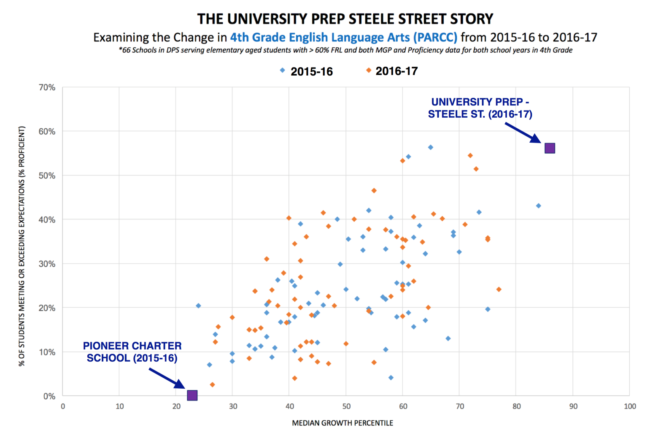03.01.18The University Prep Turnaround, Part 4: Clare Lundquist Talks Academics

Academic success means balancing support and challenge
This is the fourth in a series of posts written by David Singer and his staff at University Prep – Steele Street in which they describe their lessons in taking over and turning around a previously failing school. I describe a bit more about the series here. And you can read the two previous posts here here and here..
Today, Clare Lundquist talks academics. She reflects on some of the biggest challenges, such as: How do you work to meet the needs of children who are significantly behind grade level while simultaneously ensuring they regularly and successfully engage in rigorous grade level content?
Clare served as a founding teacher of North Star Farimount Elementary, Newark, New Jersey, part of Uncommon Schools. She launched her teaching career under the leadership of Juliana Worrell. After completing a few years of teacher coaching through The New Teacher Project in Chicago, Clare shifted back into the classroom at University Prep’s Arapahoe Street campus in the 2013-14 school year. She became a grade-level coach and then Dean of Academics at Steele Street and is currently the Principal of University Prep – Steele Street where she is working to ensure the story of the school’s success in year one (see chart below) is carried over into years of sustained success for the children and families the school serves.

In our first week of leading University Prep – Steele Street we administered diagnostic assessments in both literacy and math to gauge what skills and knowledge scholars had to begin the year. In math, our 1st graders took the end of year Kindergarten assessment, our 2nd and 3rd graders took the end of year 1st grade assessment, and our 4th and 5th graders took the end of year 2nd grade assessment. Across the school, averages were in the 20-30% range. We also administered the STEP literacy assessment to each scholar in the building (STEP is a diagnostic literacy assessment from the University of Chicago’s Urban Education Institute). On average, scholars were two to three grade-levels behind in reading. Based on assessments administered in the spring to samples of scholars from all grade levels and historic data sets from the school, we knew children would come in behind grade-level, but we did not realize just how far behind they would be. The urgency behind our work quickly became more evident, more present, and more palpable. Using this data, we launched a plan to both remediate essential skills and push grade-level content simultaneously in order to catch scholars up as quickly as possible. Expedited growth became our mantra with no minute or second to spare given the severity of our diagnosis.
In math, our 3rd, 4th, and 5th graders started the year with Unit 1 of our 2nd grade math curriculum, which has a heavy focus on number sense with hundreds, tens, and ones, and place value – essential background knowledge and foundational thinking for upper grades. We then gradually built up to grade-level place value work. We ran the same framework for each key mathematical concept – number sense, multiplication and division, fractions, decimals, measurement – start with the grade-level unit that introduces that concept, and build up to grade-level work over time. With the rigor of Common Core expectations in the upper grades, we recognized a need to rebuild foundational procedural and conceptual knowledge that was absent from our scholars’ existing mathematical backgrounds – not because they couldn’t do the work… simply because they hadn’t received the education they needed and deserved.
We used our three math blocks, Spiral Review (20 minutes), Math Class (60 minutes), and Problem of the Day (40 minutes), to attack different aspects of rigor while continuing to remediate skills. Spiral Review was used to attack fluency and procedural gaps, targeting standards from previous grade-levels that built up to key grade-level skills. Math Class was used to teach key procedures and concepts from previous grade-levels that quickly built up to essential grade-level knowledge and skills. Finally, Problem of the Day was designed to attack the conceptual and application aspects of rigor that strategically aligned to the concepts and procedures taught in Math Class so that scholars had the opportunity to practice that same mathematical thinking in real-world application settings. This curricular plan helped to close foundational gaps swiftly, build scholars’ confidence in their problem solving and overall math abilities, and ultimately resulted in scholars being able to access grade-level content. By the end of the year, our scholars had the highest median growth percentile (MGP) in mathematics (91) in the state of Colorado (#1 out of 1,500 schools) – an incredible testament to the relentless work of our teachers, the incredible grit of our scholars, and the intentional behind-the-scenes decision making by our instructional leadership team.
Literacy had a similar story. Scholars engaged in three differentiated literacy groups each day (40 minutes each), aligned to their reading level according to the STEP assessment. Scholars received one reading comprehension block, one block focused on word solving and fluency (which was an unanticipated gap in upper grades), and one block focused on independent work aligned to instructional needs either computer-based or completed through a written assignment in response to a text based question (providing teachers with an additional set of data/information about scholar learning). Additionally, scholars engaged in English Language Arts block for one hour each day. We followed a similar framework in ELA as we did in Math, starting with 3rd grade ELA curriculum and building up to grade-level texts over the course of the year. Again, the intentional work done by teachers to target literacy groups to scholar needs, use scholar work to drive instruction, and dedicate every moment of the day to closing academic gaps was the driver of academic gains in literacy. Ultimately, our scholars demonstrated what was possible in literacy growth and achievement, earning the eighth highest median growth percentile in the state (84) and increasing year-to-year proficiency by more than thirty percent.
With a plan in place to both close foundational gaps and push grade-level rigor, the key to success was using data to drive instruction on an in-the-moment, daily, weekly, and quarterly basis. Teachers aggressively monitored in classrooms to catch misconceptions and address them in the moment. Teachers and coaches looked at scholar work weekly (and often daily) to determine next steps in instruction. Coaches analyzed growth in Spiral Review standards on a weekly basis to determine where gaps were closed, and what gaps still existed so that we could continue to target those standards. Teachers and coaches analyzed quarterly assessment data to design reteach plans, rebuild scope and sequences, and continue to address foundational gaps in both math and literacy.
Ultimately, every individual (scholars, teachers, leaders, and families) was committed to achieving the near impossible, and while the effort was quite honestly exhausting, it was a model of the “good exhaustion” that all of us in the world of public education aspire to – the kind of tired where you can lay your head down on your pillow at night and know, with empirical data and evidence in hand, that children are growing and that your promise of a high-quality education is coming true.

It seems as if you all are doing very hard and very important work. Thanks for talking about it. A question: I may be misunderstanding the chart, but just to clarify–the Pioneer and University Prep “dots” represent different cohorts of students, correct? That is, the growth numbers of 4th graders from two years ago vs. the growth numbers of 4th graders from one year ago. It’s not quite an apples to apples comparison. Moreover, when you’re talking about cohort sizes of 40 or 50 (what I’m inferring from the enrollment numbers), are the numbers that robust? I don’t mean to be a wet blanket, but it might be a bit early for holding up this school as a model (not saying it isn’t a model, just that the declaration could be coming a little soon–particularly if the previous school disproportionately suppressed the student’s achievement and we’ve got some bounce-back). Am I being too skeptical?
You’re correct. it’s a comparison of different cohorts so it’s not exact apples to apples and that matters. It’s worth noting that the previous school’s results were not anomalous… ie there were multiple data point on under-performance. You’re also correct that a small cohort size is worth being skeptical of. To be fair to the school i think they are very aware that there is a long way to go. That said the scale of the change is immense (basically they went from almost no one proficient to almost everyone) and the idea that a school that we assume cannot in fact often can is worth paying attention to- though it’s legitimate ot see it as a hypothesis and not a conclusion
Fair enough. And clearly something good is happening at the school. I’ve seen an instance of a MGP in the 90s at my kids’ public elementary school, know how rare that is, and also know that simply doesn’t happen without inspired and effective teaching (it also usually requires under-performance from the previous year). That said, I’d be very curious to see the growth and achievement numbers for this school’s second year (along with fifth grade growth numbers for this fourth grade cohort). Fingers crossed that they are able to keep the momentum.
This is a great success story. This post discusses what you did do. Can you elaborate on what you *didn’t* do? How did you change the schedule to make time for the multiple math and ELA blocks, and what got left off the schedule (or shortened) in order to create that time?
I have the same question as Colin. Our school system doesn’t eliminate much, rather more is added, resulting in less effective implementation of anything we do.